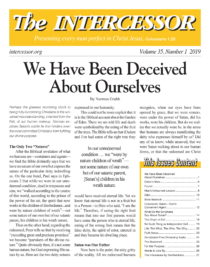
Man’s Unlearned Lesson
Although Christians are familiar with the biblical account of the fall of man and the Gospel of redemption, few have seen beyond the symbols to the principles of the spiritual kingdom. This excerpt from Norman Grubb’s God Unlimited highlights God’s “lessons” to reveal who we are, how we function, and His totality.
The Meaning of the Fall
There is a double fall recorded in the Bible–of Lucifer and of Adam. What this fall meant was the decisive choice of a created spirit to reject its predestined freedom in the service of God, and to take the road of the unexplored alternative, the possibility of going the opposite way, into the bondage of self-sufficiency, becoming the spirit of self-love in place of containing the Spirit of self-giving.
The very name Lucifer, Light-bearer, implies that this exalted being, probably the highest of all created beings according to the descriptions in Isaiah 14:12-15 and Ezekiel 28:11-17, was only to be the manifestor of the Eternal Light, not the light in himself, which no creature can be. He took that “qualitative leap” which broke open the kingdom of hell, of which he became the originator, its god, the father of lies, the primal sinner, the sin-spirit. He set himself to replace God by becoming a god in reverse, and thus “fell” irrevocably, unredeemably from the kingdom of God’s heaven, having fixed himself in the total opposite.
The fall of Adam, which has involved us all, was of the same quality, but not the same quantity. There are some significant facts about the account of the fall. Why was Adam set in the garden between two unique trees, both said to be in the midst of the garden, therefore close to each other, both marked out by what is said of them and the names given them as no normal trees? Plainly they were symbolic, for the fruit of no tree gives eternal life or eternal death.
Eternal life, we have seen, is a Person, the Spirit of life, and eternal death the same, the spirit of error. These trees represented the two Gods, the Triune God and the god of this world, just as the fruit of a tree still symbolizes Christ our life in the Lord’s supper.
Hidden Lessons
What original command, the only command, was given Adam? To eat, for eating is receiving, the basic function of the human self. It is most striking that here at the creation of man this was the only command given him, for it is still the only command–“Receive ye the Holy Ghost.” “To as many as received Him…” But there was also a prohibition, “Don’t eat of the wrong tree.” Remarkable that nothing was said to Adam about eating of the right tree, and there was never one indication that he paid any attention to that tree or showed any interest in it. Why? Because, as intelligent and free people, we must understand who we are and why we are and how we function.
These incidents in the Garden of Eden were education, not probation as we are usually told they were. Man must understand himself, then he can act intelligently; which, in its minute way, is the purpose of my writing: to help mixed-up Christians sort things out, starting with themselves. So, in effect, God said to Adam, “Just eat, just learn that is the primary function of a human being–receptivity.”
But there was another subtle piece of education wrapped up in this, subtle because man must learn it by himself, and not have it outwardly spoon-fed to him. “Don’t eat of the wrong tree” would mean that, as a free being, he could go the wrong way; and supposing he was tempted to do so, then what? There lay the hidden lesson. Humans are containers, to be possessed by another Spirit in the human spirit. They are slaves to be bossed (Rom. 6:16). They do not boss themselves. If therefore Adam feels the pull to go in the wrong direction, it is not in him to resist or refuse. But he and Eve did feel that pull. So then what?
There was the tree of life, all the positive power in it to do the right and resist the wrong, for that tree was Christ. Adam never so much as glanced in its direction, because it never dawned on him that humans are basically helpless, and that his deliverance could not be in his own resistance, but only in the counteraction of the Spirit of Truth within him, if he took of Him. He never did. He never even glimpsed the basic lesson man has to learn, and so he was shanghaied straight into the trap. He remained a recipient, for man always is that, but he received the wrong spirit through the wrong tree–“the spirit that now worketh in the children of disobedience,” the spirit of self-sufficiency, the spirit of self-love, the spirit of error.
Man’s Helplessness
That is why man has to take the long, long trail back to the discovery of his helplessness, a trail that only ends when we reach Romans chapter seven, a trail which has many a booby trap in it, many a tree-root to trip the unwary; and it is a trail nearly always trodden after the new birth, not before, because we have become so completely at home in the illusion of our self-sufficient selves that we do not lightly learn the lesson that the father of our race failed to learn. But we must learn it, because we say again, if God is going to live His life intelligently in intelligent and willing humans, they must learn and accept the truth about themselves as well as about Himself; and that is also precisely why we are busying ourselves about talking these things over in such detail.
Even the facts of the Fall and our consequent condition are rarely known. Few seem to have grasped that man is not just an independent self doing as he pleases and doing it in his own strength. He never has been this. He has always been indwelt by a god. He has always had an inner union–to whom? “Greater is He that is in you (the believer) than he that is in the world.” Who is this second “he” in the world, if not the Satanic spirit? And he is actually named a few verses later (1 John 4:6): “Hereby know we the Spirit of truth and the spirit of error.” We have already quoted the great passage descriptive of the condition of fallen humanity–Ephesians 2:1–3–which includes that statement, “the spirit that now worketh in the children of disobedience”; or the other, “in whom the god of this world hath blinded the minds…”
Sin is a Person
The fact that is hidden from many is that sin is essentially a person, just as holiness is a Person. Holiness is the “Spirit of holiness” (Rom. 1:4), the Holy Spirit. We have pointed out all along that since the human is the container of the Divine Person, all goodness, love, righteousness, wisdom, power, holiness and the rest are, not we, but HE in us, “Jesus Christ who has been made unto us wisdom, righteousness, sanctification, redemption.”
But the opposite is equally and logically true. Sin is not a thing, but an indwelling person, the spirit of fear, the spirit of bondage, the evil spirit, the spirit of the world, the spirit of anti-Christ. Sins are that spirit expressing himself through the human faculties and appetites, just as holiness and love are the Other Spirit expressing Himself through the same channels. Thus a pregnant word is spoken of the first sin recorded after the fall–the sin of Cain, when John says that he “was of that wicked one and slew his brother.” Precisely, it was not primarily Cain that was the murderer, but he whom Jesus called “a murderer from the beginning”–through Cain.
This is important because our very premise is wrong if we think that our first father could have resisted temptation. If he could, we can. But can we? Is not that our problem and failure, until we learn that the way to meet temptation is by recognizing the One in us, and not by struggling against it ourselves?
We start mixed-up, if we start by thinking that the Garden of Eden was a scene of probation to try men out. God is no such experimenter, dangling men on a string to see how they will react. God knoweth our frame that we are but dust, and He only puts us through absolutely necessary grades of education that we may learn, even as the Son Himself had to “learn obedience (recognition of His Father in action in Him) through the things which he suffered (temptations)”; and thus we can become eternally free, healthy, happy cooperators with God, knowing exactly who He is and who we are, and loving the relationship.
The Critical Difference
One other fact should be noted. I said that Adam’s fall was qualitatively the same as Lucifer’s, but not quantitatively. Lucifer’s fall was total. He chose in himself to be a god of another quality, and thus set himself as a rival and alternative to God. His sin and fall were absolute and irrevocable. He became god in reverse.
Adam’s fall was of the same quality, but not quantity. He fell through the temptation of another, through deceit, lies, misrepresentation. He was responsible and therefore guilty, for he chose to follow instead of seeking the way of escape right there available to him, and therefore his fall had the same quality of disobedience and rebellion; but it was not in quantity complete and absolute in the sense of an open-faced rejection of God. His interest was rather the attractions of the flesh than revolt against God. If he could have kept both God and sin, he would have done so.
His outlook was not totally reversed. He had not irrevocably chosen evil to be his good. He was more a kidnapped slave than a willing son of the devil; indeed Scripture speaks of us as children, not sons, of the evil one, and a child is defined as “differing nothing from a servant.” Adam, therefore, knew good and evil, whereas Satan knows only evil as his good. Adam had the moral sense, the conscience, the “law written in the heart,” an impress of the image of God in him not obliterated as in Satan, and God could and did meet and talk with him immediately after his fall. Adam was redeemable.





